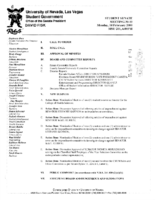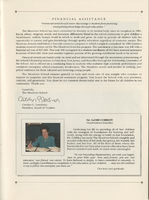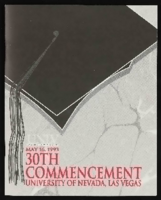Search the Special Collections and Archives Portal
Search Results

Meeting minutes for Consolidated Student Senate, University of Nevada, Las Vegas, February 14, 2000
Date
Archival Collection
Description
Text

Transcript of interview with Carol Harter by Suzanne Becker, April 20, 2007
Date
Archival Collection
Description
Carol Harter and her husband of 46 years started their married lives by running away from college in their sophomore year. They spent the 60's working toward their degrees. Carol earned her bachelor's in 1964 and her master's in 1967. One of her professors encouraged her to go for her PhD at a time when women simply did not aspire to such heights. Dr. Harter completed her PhD in 1970, and because her husband wanted to work on his doctorate, they moved to Athens, Ohio. She taught at Ohio University while he completed his courses. They lived and worked and raised their children there for 19 years. Carol held the positions of ombudsman (2 years), vice president and dean of students combined (6 years), and vice president at the university, and then accepted the position of president at SUNY Geneseo (in New York). Carol was nominated for the presidency at UNLV in 1994, and she accepted the job in 1995. Her career here has been phenomenal, as she saw the potential of this very young university and set about bringing in the faculty, the funding, the buildings, and the vision to create a first-rate research oriented facility. During her administration, the new library went up, the law school and dental school were built, and over 550 million in gifts and pledges were raised. This includes money raised for the "Invent the Future" campaign. Under Dr. Harter's guidance, women's sports were expanded, multiple graduate degrees were developed, more money for research and buildings was raised, and UNLV has become a major research university. Dr. Harter leaves behind a rich legacy, including her vision of the UNLV Midtown project, a cultural district where the university may one day interface with the community.
Text
Philis Beilfuss oral history interview, 2013 January 31
Level of Description
Scope and Contents
After receiving nursing and paramedic training in Chicago in 1973, Beilfuss moved to Las Vegas, Nevada in 1985 practiced emergency room services as Sunrise Hospital. She taught at Clark County Community College until 1996. She also served with the North Las Vegas Fire Department and the Southern Nevada Health Board, which included formulating EMS responses in Clark County.
Archival Collection
Collection Name: History of Emergency Medical Services in Nevada Oral History Interviews
Box/Folder: Digital File 00
Archival Component

Erika Castro interview, November 12, 2018: transcript
Date
Archival Collection
Description
Interviewed by Maribel Estrada Calderón. Barbara Tabach and Laurents Banuelos-Benitez also participate in the questioning. Erika Castro was born in Mexico City in 1989. At the age of three, she migrated with her family to the United States. She remembers entering Kindergarten without knowing how to speak English. She graduated from the College of Southern Nevada. Castro has since been a political activist. Subjects: PLAN, Planned Parenthood, Environmental Justice, UndocuNetwork, Deferred Action for Childhood Arrivals, DREAM Act
Text
III. Legislative Branch, 1973 to 2019
Level of Description
Scope and Contents
The Legislative Branch Series is comprised of Senate meeting minutes and agendas from 1973 to 2018 created by the Consolidated Students of the University of Las Vegas, Nevada (CSUN). The Legislative Branch houses the CSUN senate which is comprised of twenty-five senators from all nine of the University of Nevada, Las Vegas (UNLV) colleges.
Archival Collection
Collection Name: Consolidated Students of the University of Nevada, Las Vegas Records
Box/Folder: N/A
Archival Component

Program from event at Treasure Island at the Mirage, Tenth Anniversary Scholarship Benefit for the Meadows School, May 20, 1994
Date
Archival Collection
Description
The "Presidential Evening" event at Treasure Island was held to raise funds for the Nat Hart Scholarship Endowment Fund and General Scholarship Fund for the Meadows School in Las Vegas.
Text
Christopher C. Hudgins oral history interview
Identifier
Abstract
Oral history interview with Christopher C. Hudgins conducted by Claytee D. White on May 18, 2016 for the Boyer Early Las Vegas Oral History Project. Hudgins open his interview by discussing his upbringing in Virginia, his education, and the manual labor jobs he worked as a teenager. Hudgins then describes his introduction to American folk music and moving to Las Vegas, Nevada in 1976. Hudgins then recalls what the University of Nevada, Las Vegas (UNLV) was like in 1976 and how he became familiar with the city. Hudgins then discusses his career and scholarship while at UNLV as a chairman in the English department, and his interest in broadcasting. He then explains conflicts between the Board of Regents and the UNLV faculty, the expansion of UNLV related construction on Maryland Parkway, and his interest in becoming a dean. Hudgins describes his goals as dean of the liberal arts college, the challenges of implementing grants for liberal arts projects, and his views on college athletics. Lastly, Hudgins recalls attending a Nobel Prize ceremony as an invited guest of Harold Pinter, and his association with the City of Asylum organization.
Archival Collection
Clarence Gilyard oral history interview
Identifier
Abstract
Oral history interview with Clarence Gilyard conducted by Barbara Paige on December 02, 2014 for the African Americans in Las Vegas: a Collaborative Oral History Project. Gilyard begins the interview by discussing his upbringing on United States Air Force bases, his father's career as an Airman, and the advantages he had attending Air Force schools as a child as opposed to attending public schools, where he may have faced discrimination as an African American. He describes his higher education, playing college football, and later pursuing a career in acting after becoming involved in local theatre while attending college at California State University, Long Beach. Gilyard continues, detailing how he gained more acting work and eventually acted alongside actors like Jim Carrey, Andy Griffith, and Chuck Norris, as well as starred in film and television series such as Top Gun, Die Hard, Matlock, and Walker, Texas Ranger. He concludes by discussing his career as an acting teacher and continuing his own education.
Archival Collection

University of Nevada, Las Vegas (UNLV) 30th commencement program
Date
Archival Collection
Description
Commencement program from University of Nevada, Las Vegas Commencement Programs and Graduation Lists (UA-00115).
Text
Barbara Taylor oral history interview
Identifier
Abstract
Oral history interview with Barbara Taylor conducted by Karen Schank on January 9, 2011 for the Nevada State College Undergraduate Oral History Project. In this interview, Taylor talks about her birth in Reno, Nevada, growing up in Minden Valley, Nevada, and moving to Las Vegas, Nevada in 1943. She reflects on her education, her parents careers, and her early marriage before describing the couple's first home in Henderson's "Victory Village." Later, she discusses her own career and what it was like living in Nevada in the 1950s and 1960s.
Archival Collection
